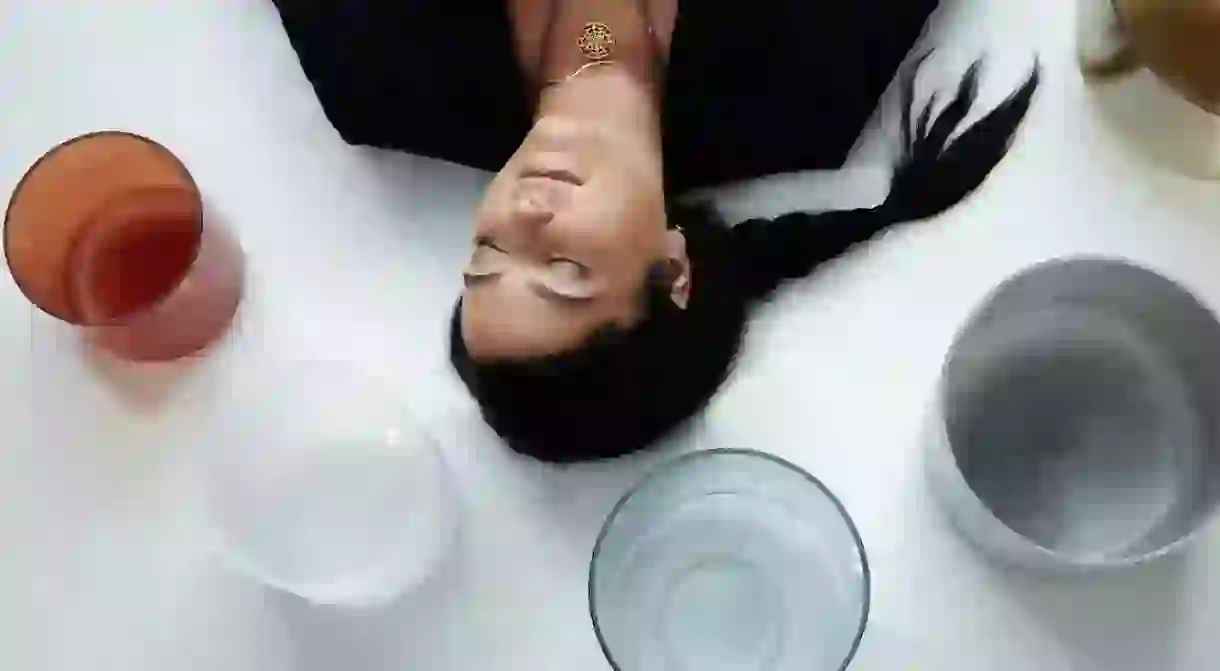Sound Baths Are Making Waves in NYC

On virtually any night of the week, small groups of New Yorkers lie shoulder to shoulder on the floor, close their eyes, and have highly resonant, overtone-emitting instruments played over their bodies. The sounds that roll through the room in vibrational waves allow the participants at these gatherings to enter deeply meditative states. These experiences are known as Sound Baths, and they’ve developed a cult following among certain sets of stressed out New Yorkers.
On a Monday evening at Inscape, a cavernous meditation studio in the Flatiron district, people are slowly entering “The Alcove” room. They select their meditation mat of choice and lie down, swinging their legs over a bolster and covering themselves with soft blankets. Overhead, macrame weavings drape from the roof like elegant spider webs. A dulcet female voice introduces this evening’s meditation—Deep Sound 44: Resonant Reflection.
Although it’s a recording, the drone of crystal singing bowls sounds as if it’s live, thanks to a fancy speaker system creating an immersive experience that lulls the room into heavy relaxation mode. At one point a loud snore from the far corner joins the symphony, and the facilitator has to gently intervene.

“We included sound sessions in our offering because we understand how powerful they are when it comes to empowering deep rest and relaxation,” explains CEO and founder of Inscape, Khajak Keledjian. “When your awareness is engaged during a sound session, and you’re actively listening, your brain’s electrical activities diminish significantly, so your mind quiets down and the brain waves cycle down to low theta brain waves. Theta State is a state of very deep relaxation, accessed in meditation, hypnosis and during REM Sleep. It’s the first stage of the phase when we dream.”
Well that explains the snoring.
In a frenetic city like New York, anything that enables a steady downshift is welcome, as are sounds that don’t resemble sirens or construction. Sabi Datoo-Lalji, a freelance writer and consultant, stumbled into her first sound bath by accident, when she arrived late for her usual guided meditation class. Now she’s hooked.
“I love the way my conscious and sub-conscious merge at the peak of bells tolling, and the utter peace I feel just focusing on the sound,” she says. “I also love the feeling of walking out the room and taking that sense of peace with me. It seems to stay for the rest of the day.”
For people who have real difficulty focusing purely on the flow of their breath during meditation, sound baths can be a game-changer. Not only do you hear the music, you feel sound vibrations passing over and around the body, warping your sense of space and often your sense of time. Some people become so deeply dissolved in the experience that they see visions. In fact, sound baths are so affecting, that hanging around to discuss what went down is a regular occurrence post-session.

“People are hungry for connection, so to come together and have a shared and also uniquely person experience is something we’re craving,” explains Sara Auster, sound director for The Big Quiet and MNDFL. “At the end [of a session] they’re wide-eyed and curious and asking questions and talking to a stranger. It opens up really interesting conversations. Rather than ‘hey, my name is…and this is my job’, it’s ‘I felt this sensation in my body’ or ‘I saw my grandmother’.”
Auster, who is a lifelong musician and meditation teacher, began hosting sound baths before it was a craze in New York. Like a conductor, she expertly directs sounds to fit the context, from intimate one-on-ones to mass experiences for hundreds of people.
Her biggest piece of advice for the sound bath-curious is to do your research. “Saying you went to a sound bath is like saying you went to a concert. Who was the artist? Who was facilitating? There are so many takes on what this is,” she says. “Decide who is facilitating the experience for you, go with an open mind and bring a friend so you can discuss it afterwards.”
She thinks for a moment, then adds: “Although, strangers connect! It’s incredible, especially here. New Yorkers laying shoulder to shoulder with other New Yorkers. It still blows me away.”













